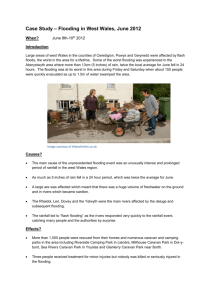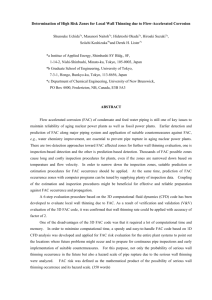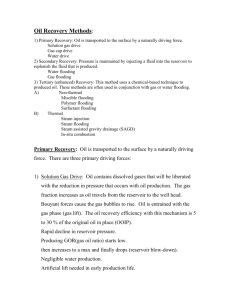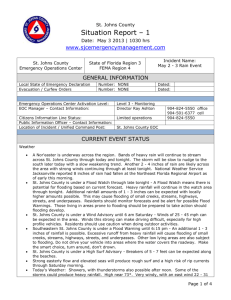solution 1
advertisement
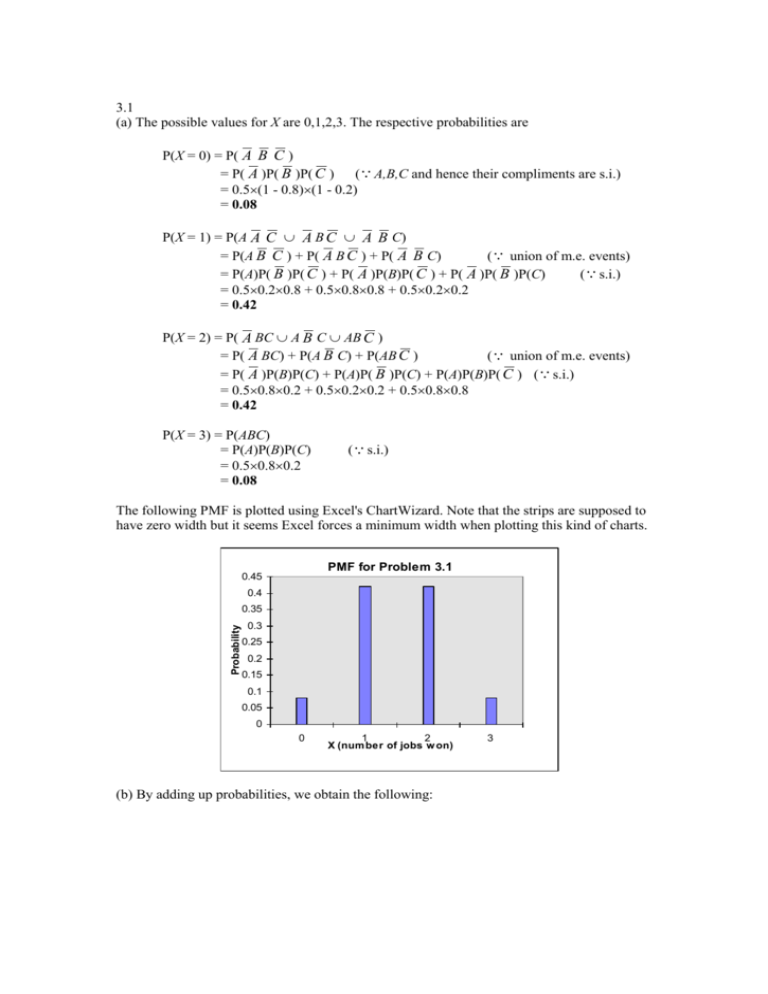
3.1 (a) The possible values for X are 0,1,2,3. The respective probabilities are P(X = 0) = P( A B C ) = P( A )P( B )P( C ) ( A,B,C and hence their compliments are s.i.) = 0.5(1 - 0.8)(1 - 0.2) = 0.08 P(X = 1) = P(A A C A B C A B C) = P(A B C ) + P( A B C ) + P( A B C) ( union of m.e. events) = P(A)P( B )P( C ) + P( A )P(B)P( C ) + P( A )P( B )P(C) ( s.i.) = 0.50.20.8 + 0.50.80.8 + 0.50.20.2 = 0.42 P(X = 2) = P( A BC A B C AB C ) = P( A BC) + P(A B C) + P(AB C ) ( union of m.e. events) = P( A )P(B)P(C) + P(A)P( B )P(C) + P(A)P(B)P( C ) ( s.i.) = 0.50.80.2 + 0.50.20.2 + 0.50.80.8 = 0.42 P(X = 3) = P(ABC) = P(A)P(B)P(C) = 0.50.80.2 = 0.08 ( s.i.) The following PMF is plotted using Excel's ChartWizard. Note that the strips are supposed to have zero width but it seems Excel forces a minimum width when plotting this kind of charts. PMF for Problem 3.1 0.45 0.4 Probability 0.35 0.3 0.25 0.2 0.15 0.1 0.05 0 0 1 2 X (num ber of jobs w on) (b) By adding up probabilities, we obtain the following: 3 Distribution Function for X (# of jobs won) FX(x) 0.92 + 0.08 = 1 0.5 + 0.42 = 0.92 1 0.08+0.42 = 0.5 0.5 0.08 0 1 2 3 4 x (c) P(X 2) = FX(2) = 0.92 (note: FX is right-continuous, i.e. FX(a) = FX(a+) (d) P(0 < X 2) = FX(2) – FX(0) = 0.92 – 0.08 = 0.84 3.5 Let R = "Road completed within 15 months"; B = "Bridge completed within 15 months" P(Project completion within 15 months) = P(RB) = P(R)P(B) since R and B are s.i. So let's first calculate the individual probabilities P(R) = area of rectangle PDF from t = 12 to t = 15 = (1/6)(15 - 12) = 0.5, while P(B) = area of triangle PDF from t = 10 to t =15 = (15 - 10)(1/5/2)2 = 0.25 Hence P(RB) = 0.50.25 = 0.125 3.6 Let Fi denote the event "device fails to detect the i-th existing crack" , where i goes from 1 to N, N being the total number of cracks. (a) Given: N = 2. In this case, P(two cracks both go undetected) = P(F1 F2) = P(F1)P(F2) = 0.20.2 = 0.04 (b) Let FAC denote "device fails to detect any crack at all”. If there is indeed no crack, the device certainly will not detect anything, i.e. P(FAC | N = 0) =1; while we’re given P(successful detection | N = 1) = 0.8, hence P(FAC | N = 1) = 1 – 0.8 = 0.2, and P(FAC | N = 2) = 0.04 as calculated in part(a). Note that N is a random variable in this case, hence by the total probability theorem, P(FAC) = P(FAC | N = 0)P(N = 0) + P(FAC | N = 1)P(N = 1) + P(FAC | N = 2)P(N = 2) = 10.3 + 0.20.6 + 0.040.1 = 0.424 (c) The mean of N is N nP( N n) n 0 ,1, 2 = 00.3 + 10.6 + 20.1 = 0.8 The variance of N is N2 n n 0 ,1, 2 2 N P ( N n) = (0 - 0.8)20.3 + (1 - 0.8)20.6 + (2 - 0.8)20.1 = 0.36 The coefficient of variation of N is N N N = 0.36 = 0.75 0.8 (d) By Bayes' theorem, P(N = 0 | FAC) = P(FAC | N = 0)P(N = 0) P(FAC) = 10.3 0.424 0.708 Picture for parts (b) and (d) (not to scale; just to provide a qualitative idea): N=1 N=0 N=2 Failure to detect any crack 3.17 Given: M is Gaussian with mean 50 and standard deviation 0.2*50, i.e. M ~ N(50, 10) (a) Let O denote the clamped end. If a load of 3 kips is applied at the free end, it gives a moment about O, M0 = (3 kips)(10 ft) = 30 kip-ft With pf denoting the beam failure probability, pf = P(M < M0) = P( M 50 30 50 ) 10 10 = P(Z < -2) 0.023 (b) The uniform load gives a moment about O 10 10 x 0 x 0 dM xdF Mu = 10 = x(0.5)dx x 0 = 0.5(10)2/2 (kip-ft) = 25 kip-ft hence pf = P(M < M0 + Mu) = P( M 50 30 25 50 ) 10 10 = P(Z < -0.5) 0.006 (c) In the case of the combined load (30 + 25) = 55 kip-ft pf = P(M < 55) = P( M 50 55 50 ) 10 10 = P(Z < -0.5) 0.3085 (d) Given event: M > 30, thus the conditional probability of surviving the combined load is P(M > 55 | M > 30) = P(M > 55 and M > 30) / P(M > 30) = P(M > 55) / P(M > 30) = P( M 50 55 50 M 50 30 50 ) / P( ) 10 10 10 10 = [1 - P(Z < 0.5)] / [1 - P(Z < -2)] 0.308538 / 0.308538 0.316 (e) For a uniform load of w (kip/ft), the resultant Mu = 50w (kip-ft). Hence if we want to enforce P(M > Mu) = 0.995, i.e. P(M > 50w) = 0.995 M 50 50w 50 ) = 0.995, 10 10 50w 50 P( Z ) = 0.995, i.e. 10 50w 50 P(Z ) = 0.005 10 P( comparing to what a table (or Excel) says: P(Z - 2.575835) = 0.005, we must have 50w 50 = - 2.575835 10 w 0.485 kip/ft (or less) 3.19 Given information: X = 30 P(X 40) = 0.9 (a) Rewriting (ii) in a standardized form, P( X 30 X 40 30 X (i) (ii) ) 0.9 (iii) If we assume X is Gaussian (i.e. normal), then (X - 30) / X is a standard normal variate, hence (iii) becomes 40 30 P( Z ) 0.9 (iv) X but, from Table A.1 of the text, P( Z 1285 . ) 0.9 . Comparing this to (iii), we must have 40 30 X 1285 . , hence X = 10 / 1.285 7.78, hence P(X < 50) = P ( X 30 50 30 ) 7.782101167 0 30 ) 7.782101167 X = P(Z < 2.57) 0.995 (b) Based on the normality assumption, P(X < 0) = P ( X 30 X = P(Z < - 3.855) 1- 0.99994 0.00006 The normality assumption leads to a finite probability for a physically impossible event, so it's no all that reasonable. (c) Now let's assume X is log-normal (i.e. ln(X) is normal) with the same expected value and variance as in (a). These allow us to determine its parameters ln(1 X ) X 2 2 = ln [1 + (7.782101167 / 30)2] = 0.0651228285 0.065 while 1 2 ln X 2 = ln (30) - 0.0651228285 / 2 = 3.368635968 3.37 Hence P(X < 50) = P(ln X < ln 50) = P( ln X = P(Z < 2.129) ln 50 3.368635968 ) 0.0651228285 0.983 X = 0.0672901095 and hence (or 0.982 if you had used approximated X 2 2 3.367552327) (a) and (b) results are quite close; the percentage difference being only about 1%. 3.20 Let T be the time (in months) between breakdowns. Given: T is log-normal, with T 6, T 15 . T 15 . 0.25 6 which is small, hence we may use the approximation 2 T 2 0.0625, and hence ln T 2 2 ln 6 0.0625 1760509469 . 2 and are the respective variance and mean of ln(T), which is normally distributed. 2 (a) Suppose a piece of equipment is checked every T0 months. The requirement that there is "at least a 90% probability that a piece of equipment will be operational at any time" means we want "10% (or less) probability that the equipment breaks down before being maintenance is performed", hence we require P(T T0) = 0.1, or P( ln T ln T0 ) = 0.1 ln T0 1760509469 . ) = 0.1, 0.25 ln T0 1760509469 . = -1(0.1) -1.285 0.25 P(Z T0 = 4.217571418 4.22 (months) Each piece of equipment should be checked at least every 4.22 months to ensure a 90% chance of being operational. (b) "At maintenance time, the equipment still hasn't had a breakdown" means "T > 4.22". To be operational for at least one more month without any maintenance means "T > 5.22". Hence the desired probability is P(T > 5.22| T > 4.22) = P(T > 5.22 and T > 4.22) / P(T > 4.22) = P(T > 5.22) / P(T > 4.22) where P(T > 5.22) = P( ln T ln(522 . ) ) = P( Z ln(5.217571418) 1760509469 . ) 0.25 = P(Z > -0.4339) = P(Z < 0.4339) 0.668 P(T > 4.22) = 0.9, P(T > 5.22 | T > 4.22) = 0.668 / 0.9 0.742 and hence 3.21 (a) Let N be the number of rainstorms in a year. From the given PMF of N, we can calculate its mean and variance as follows: E(N) <n> = n f (n) = 0*0.3 + 1*0.4 + 2*0.2 + 3*0.1 all = 1.1 Var(N) = ( n n ) 2 f ( n) all = (0 - 1.1)20.3 + (1 - 1.1)20.4 + (2 - 1.1)20.2 + (3 - 1.1)20.1 = 0.89 (b) let R be the maximum runoff rate (in ft3 / s) in a storm; we're given that R is log-normal with median rm = 7, and COV = 0.15. From formulas 3.32(a) and 3.33, = ln(rm) = ln(7); 0.15 hence P(flooding during a rainstorm) = P(R > 8) = P( ln R ln 8 ) = P(Z > 0.890209) = 1 - P(Z 0.890209) 1 - 0.81332 = 0.187 (c) From part (b), we have the probability of flooding given one rainstorm is 0.187 (call it p). If there is zero or one storm in a year, the respective probabilities of flooding are zero and p, obviously. Furthermore, with Fi denoting "flooding occurs during the i-th storm", P(flooding in a year | 2 rainstorms in that year) = P(F1 F2) = P(F1) + P(F2) - P(F1 F2) = p + p - pp = p(2 - p) whereas P(flooding in a year | 3 rainstorms in that year) = 1 - P(no flooding at all) = 1 - P( F1 F2 F3 ) = 1 - (1 - p)3 Hence we may apply the theorem of total probability to calculate P(flooding in a year) = P(flooding | n rainstorms in a year)P(n rainstorms in that year) n 0 ,1, 2 , 3 = 0*0.3 + p*0.4 + p(2 - p)*0.2 + [1 - (1 - p)3]*0.1 0.189 (where p = 0.186676723 from (b)) 3.27 Since the rainfall return period is 10 years, the probability of sewer flooding is 1 = 0.1 (probability per year) 10 years (a) Suppose the first flooding occurs in the T-th year, then T follows a geometric distribution with parameter p = 0.1 , hence P(first flooding in the third year) = P(T = 3) = p (1 - p)3 - 1 = 0.1 (0.9)2 = 0.081 (b) Let Fi denote "there is flooding during the i-th year" P(any flooding within the first 3 years) = 1 - P(no flooding at all within the first 3 years) = 1 - P( F1 F2 F3 ) = 1 - P( F1 )P( F2 )P( F3 ) = 1 - (1 - p)3 = 1 - 0.93 = 0.271 (assuming s.i.) (c) Let X be the total number of years with flooding among the first five years, then X follows a binomial distribution with p = 0.1 and n = 5. Hence P(flooding in 3 of the first 5 years) = P(X = 3) = 5! (01 . ) 3 (1 01 . ) 5 3 3!(5 3)! = 0.0081 (d) Let Y be the total number of floods within 3 years, then Y follows a binomial distribution with p = 0.1 and n = 3. Hence P(one flood within 3 years) = P(Y = 1) = 3p(1 - p)2 = 0.243 Note: in Excel, one can get the binomial probability b(x; n,p) by typing the following: =binomdist(x,n,p,false) For example, in any empty cell, typing in (hit enter after typing it) =binomdist(3,5,0.1,false) gets you the answer (0.0081) in part (c).



